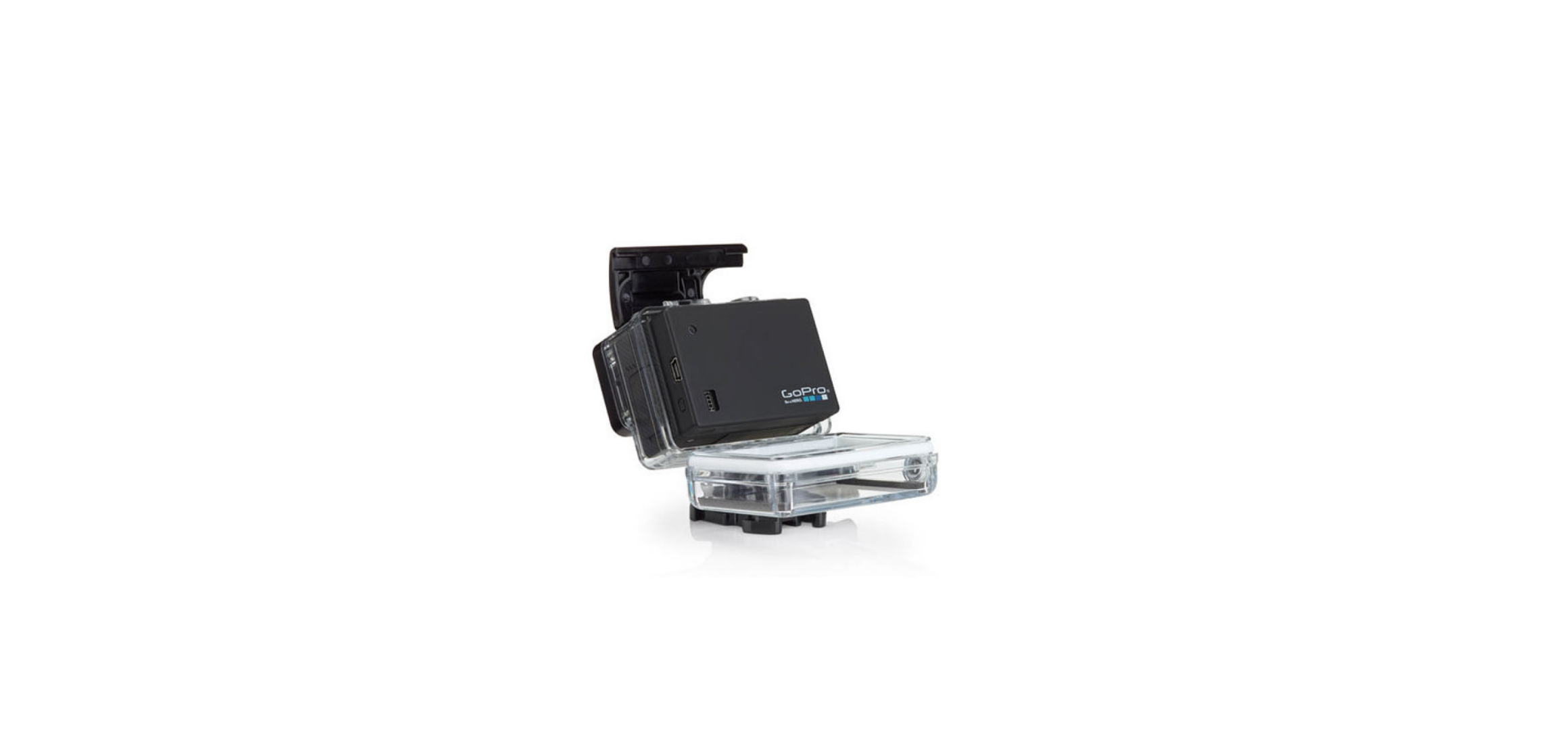GoPro Battery BacPac User Manual

To download this user guide in a different language, visit gopro.com/support.
Features

Battery BacPac Overview
The Battery BacPac attaches to the back of your GoPro* to increase battery life. It’s perfect for long-duration Time Lapse photo sessions, endurance motorsports racing, or any application in which you need extended battery life. When connected and powered on, the Battery BacPac serves as an initial source of power. Once the Battery BacPac is depleted, your GoPro automatically switches over to draw from the battery inside the camera. You can charge the BacPac using the GoPro Auto or Wall Charger (sold separately), another USB charger, or a computer.
Attaching the BacPac to Your GoPro

- Slide the hooked end of the BacPac into the groove on the right side of the camera body.

- Insert the BacPac connector into the HERO Port on the back of the camera.
Removing the BacPac from Your GoPro

- Pull back on the left side of the BacPac marked with the arrow to disconnect it from the HERO Port.

- Slide the hooked end of the BacPac out of the camera groove.
Checking the Battery BacPac Charge Status
The camera status screen displays the charge status for both the Battery BacPac and the internal camera battery. The top row indicates the Battery BacPac status and the bottom row indicates the internal camera battery status. The LCD window on the Battery BacPac displays the charge status for the BacPac.
TO CHECK THE BACPAC CHARGE STATUS

Charging the Battery BacPac

For fast charging, connect the Battery BacPac to a USB wall charger (sold separately). You can also charge the Battery BacPac by connecting it to your computer using the included USB charging cable. Note: Be sure that the computer is connected to a power source. If the LCD window on the BacPac does not indicate that the BacPac is charging, use a different USB port. During charging, the LED status light on the Battery BacPac remains lit until charging is complete. When completely charged, the LCD window on the BacPac displays a full battery icon. We recommend charging the BacPac fully before use. No damage occurs to the camera or Battery BacPac if used prior to a full charge.
Swapping Housing Backdoors
To use the Battery BacPac with your camera housing, you must swap out the original housing backdoor for a BacPac Backdoor. Two BacPac Backdoors are supplied with the Battery BacPac:
- Standard BacPac Backdoor—Makes your camera waterproof to 131’ (40m). Use when shooting underwater or in wet, damp, or dirty conditions.
- Skeleton BacPac Backdoor—Not waterproof. Use in dry, dirt-free environments only. Enables enhanced audio capture.
The Battery BacPac also comes with a straight-arm extension, which provides a full range of motion when a deeper backdoor is attached to the housing.
Battery Information
BATTERY STORAGE AND HANDLING
The camera contains sensitive components, including the battery. Do not drop, disassemble, open, crush, bend, deform, puncture, shred, microwave, incinerate, paint or insert foreign objects into the battery opening on the camera. Do not use the camera or the battery if it has been damaged—for example, if cracked, punctured, or harmed by water. Disassembling or puncturing the battery can cause an explosion or fire.
Avoid exposing your camera and battery to very cold or very hot temperatures. Low or high-temperature conditions may temporarily shorten the battery life or cause the camera to temporarily stop working properly. Avoid dramatic changes in temperature or humidity when using the camera, as condensation may form on or within the camera.
The camera housing protects the camera and battery from water damage. For more information, see Swapping Housing Backdoors. Do not turn on your camera if it is wet. If your camera is already on, turn it off and remove the battery immediately. Allow the camera to dry thoroughly before using it again. Do not dry the camera or battery with an external heat source such as a microwave oven or hair dryer. Damage to the camera or battery caused by contact with liquid is not covered under the warranty. Do not store your battery with metal objects, such as coins, keys, or necklaces. If the battery terminals come in contact with metal objects, this may cause a fire.
BATTERY DISPOSAL
Most rechargeable lithium-ion batteries are classified as non-hazardous waste and are safe for disposal in the normal municipal waste stream. Many localities have laws in place requiring battery recycling. Check your local laws to make sure that you can dispose of rechargeable batteries in your regular trash. To safely dispose of lithium-ion batteries, protect terminals from exposure to other metal with packing, masking, or electrical tape so they do not cause a fire while being transported.
Lithium-ion batteries, however, do contain recyclable materials and are accepted for recycling by the Rechargeable Battery Recycling Corporation’s (RBRC) Battery Recycling Program. We encourage you to visit Call2Recycle at call2recycle.org or call 1-800-BATTERY in North America to find a convenient recycling location. Never dispose of a battery in a fire because it may explode.







